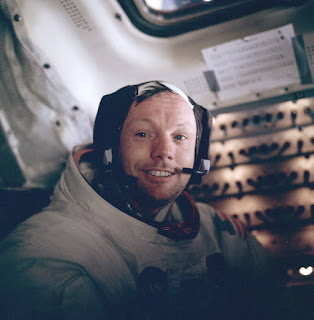To manage the operational and procedural complexities of a Moon mission, NASA devised a number of artifacts, such as mission rules, countdown sequences, checklists, and flight plans. Another important concept in this context was the timeline.
Basically, a timeline showed the actions to be performed by an astronaut or a spacecraft system as a function of time. It shows WHO is doing WHAT and WHEN and WHERE. Nothing out of ordinary here. All of us sort of do this all the time in our minds, without really being aware of it. But what really set the Apollo flight plans apart was the practice of combining two or more timelines together.
The attached image shows the timeline snapshot for when lunar module Eagle landed on the Moon. At a quick glance we can see the planned activities for Neil Armstrong (CDR - Commander) and Buzz Aldrin (LMP – Lunar Module Pilot) on Moon, Mike Collins (CMP – Command Module Pilot) orbiting the Moon and mission control team (MCC-H) at Houston.
The timeline is a superb tool to visually communicate what people are supposed to do at any particular instant. It comes really handy when planning and organizing activities involving multiple teams working on a series of tasks towards a common goal. It removes ambiguity and brings everyone on the same page (literally!). Most importantly, when creating timelines it immediately becomes evident if multiple people would need to use the same resource at same time and actions can be taken to work around any delays and deadlocks.
The Apollo mission timelines were created the old-fashioned way, using sliders, rulers and pencils. But now we can use sophisticated software tools (for example, Microsoft Project) that automatically generate timeline views based on the data we feed into them.
Basically, a timeline showed the actions to be performed by an astronaut or a spacecraft system as a function of time. It shows WHO is doing WHAT and WHEN and WHERE. Nothing out of ordinary here. All of us sort of do this all the time in our minds, without really being aware of it. But what really set the Apollo flight plans apart was the practice of combining two or more timelines together.
The attached image shows the timeline snapshot for when lunar module Eagle landed on the Moon. At a quick glance we can see the planned activities for Neil Armstrong (CDR - Commander) and Buzz Aldrin (LMP – Lunar Module Pilot) on Moon, Mike Collins (CMP – Command Module Pilot) orbiting the Moon and mission control team (MCC-H) at Houston.
The timeline is a superb tool to visually communicate what people are supposed to do at any particular instant. It comes really handy when planning and organizing activities involving multiple teams working on a series of tasks towards a common goal. It removes ambiguity and brings everyone on the same page (literally!). Most importantly, when creating timelines it immediately becomes evident if multiple people would need to use the same resource at same time and actions can be taken to work around any delays and deadlocks.
The Apollo mission timelines were created the old-fashioned way, using sliders, rulers and pencils. But now we can use sophisticated software tools (for example, Microsoft Project) that automatically generate timeline views based on the data we feed into them.




